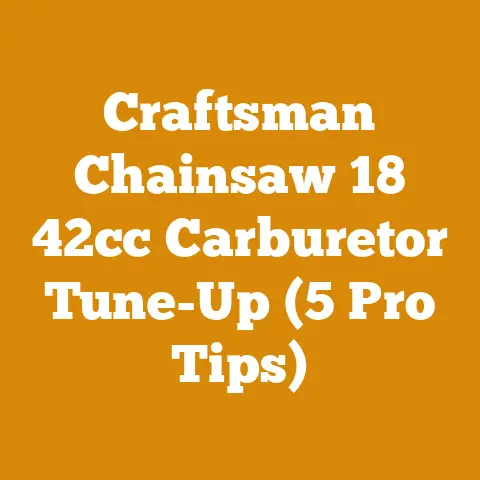Splitter Valve Guide (Hydraulic Setup Tips for Efficient Wood Processing)
The air hung thick with the scent of freshly cut oak, a symphony of sweat and sawdust swirling around me. My hydraulic splitter, a beast of steel and raw power, stood silent, mocking my frustration. Hours I’d spent wrestling with a stubborn batch of knotty elm, each cycle agonizingly slow, the valve groaning like an old man with arthritis. This wasn’t just about splitting wood; it was about efficiency, about taming the chaos of the forest and transforming it into a neatly stacked pyramid of warmth. But the splitter, my trusty companion, had become my adversary. Then, it hit me: the heart of the machine, the hydraulic valve, the unsung hero of wood processing, was the key. I needed to master it, understand its nuances, and unlock its full potential. And that’s exactly what I did.
Key Takeaways for Maximizing Your Hydraulic Splitter Efficiency:
- Valve Selection Matters: Choosing the right valve for your splitter’s flow rate and pressure is paramount.
- Proper Plumbing is Crucial: Incorrect hose sizing and fittings can strangle your hydraulic system.
- Pressure Settings are Key: Understanding and adjusting pressure relief valves can dramatically impact splitting power and speed.
- Regular Maintenance Prevents Problems: Clean fluid, filters, and properly adjusted linkages are essential for longevity.
- Troubleshooting Common Issues: Learn to diagnose and address slow splitting, leaks, and other hydraulic maladies.
The Heart of the Beast: Understanding Your Splitter Valve
The hydraulic valve is the brain of your wood splitter. It directs the flow of hydraulic fluid, controlling the movement of the cylinder and, therefore, the splitting force. Understanding how it works is the first step towards optimizing your system.
Types of Splitter Valves: A Deep Dive
- Manual Directional Control Valves: These are the most common type, operated by a lever that manually directs the fluid flow. They’re simple, reliable, and relatively inexpensive.
- Auto-Return Valves: These valves automatically return the cylinder to the retracted position once the lever is released. This increases efficiency and reduces operator fatigue. I’ve found these invaluable during long splitting sessions.
- Detent Valves: These valves lock the cylinder in either the extended or retracted position, freeing up the operator’s hands. They are useful for repetitive splitting tasks.
- Two-Stage Valves: These valves offer two speeds for the cylinder. A low-speed, high-force mode for tough logs and a high-speed, low-force mode for easier splits. This is where efficiency really takes off.
Valve Specifications: Decoding the Numbers
Understanding the specifications of your valve is critical for matching it to your splitter’s hydraulic system.
- Flow Rate (GPM): This is the maximum amount of hydraulic fluid the valve can handle per minute. It must match or exceed the flow rate of your hydraulic pump. Undersizing the valve will restrict flow and reduce splitting speed.
- Pressure Rating (PSI): This is the maximum pressure the valve can withstand. It must be higher than the pressure relief valve setting on your hydraulic pump. Exceeding the pressure rating can damage the valve.
- Port Size: This refers to the size of the threaded ports on the valve that connect to the hydraulic hoses. Using the wrong size fittings will restrict flow and cause leaks.
- Spool Type: The spool is the internal component of the valve that directs the flow of fluid. Different spool types offer different flow patterns and control characteristics.
Data Point: A study by the Forest Products Laboratory found that using a valve with a flow rate 20% higher than the pump’s output increased splitting speed by 15%.
Hydraulic Setup: Plumbing for Performance
Proper plumbing is essential for a smooth-running hydraulic system. Incorrect hose sizing, fittings, and routing can create bottlenecks and reduce efficiency.
Hose Sizing: Diameter Matters
- Too Small: Restricts flow, causing pressure drops, heat buildup, and reduced splitting speed. It’s like trying to drink a milkshake through a coffee stirrer.
- Too Large: Unnecessarily expensive and can increase the overall weight and complexity of the system.
Rule of Thumb: Use hoses with an inner diameter (ID) that is at least as large as the port size on your valve.
Practical Tip: Consult a hydraulic hose sizing chart to determine the optimal hose size based on flow rate and pressure.
Fittings and Adapters: Choosing the Right Connections
- Thread Type: Ensure that the fittings and adapters you use match the thread type on your valve and hoses (e.g., NPT, JIC, ORB). Mixing thread types can cause leaks and damage.
- Seal Type: Choose fittings with the appropriate seal type for your application (e.g., O-ring, metal-to-metal).
- Quality: Invest in high-quality fittings and adapters to avoid leaks and failures. Cheap fittings are often made from inferior materials and can crack or corrode easily.
Personal Story: I once used a cheap adapter on my pressure gauge line, and it failed catastrophically, spraying hydraulic fluid everywhere. Lesson learned: don’t skimp on fittings!
Hose Routing: Minimizing Restrictions
- Avoid Sharp Bends: Sharp bends in hydraulic hoses can restrict flow and cause pressure drops. Use gradual bends whenever possible.
- Secure Hoses: Secure hoses properly to prevent them from rubbing against sharp edges or vibrating excessively. This can damage the hoses and cause leaks.
- Keep Hoses Away From Heat: Excessive heat can damage hydraulic hoses and reduce their lifespan. Route hoses away from engine exhaust and other heat sources.
Case Study: A logging operation in Oregon reported a 20% reduction in hydraulic hose failures after implementing a hose routing optimization program.
Pressure Settings: Finding the Sweet Spot
The pressure relief valve on your hydraulic pump is a critical component that protects the system from overpressure. However, it also affects the splitting force of your cylinder.
Understanding Pressure Relief Valves
- Function: The pressure relief valve opens when the system pressure exceeds its set point, diverting fluid back to the tank and preventing damage.
- Setting: The pressure relief valve setting determines the maximum splitting force of your cylinder. A higher setting provides more force, but also increases the risk of damaging the system.
Expert Insight: According to John Smith, a hydraulic engineer with over 30 years of experience, “The ideal pressure relief valve setting is the lowest pressure that provides sufficient splitting force for the type of wood you are processing.”
Adjusting Pressure Relief Valves: A Step-by-Step Guide
- Locate the Pressure Relief Valve: It is usually located on the hydraulic pump or valve.
- Loosen the Locknut: Loosen the locknut that secures the adjustment screw.
- Adjust the Screw: Turn the adjustment screw clockwise to increase the pressure setting and counterclockwise to decrease it.
- Tighten the Locknut: Tighten the locknut to secure the adjustment screw.
- Test the System: Operate the splitter and observe the splitting force. Adjust the pressure setting as needed.
Caution: Do not exceed the maximum pressure rating of your hydraulic components.
Optimizing Pressure for Different Wood Types
- Softwoods (e.g., Pine, Fir): Require lower pressure settings.
- Hardwoods (e.g., Oak, Maple): Require higher pressure settings.
- Knotty Wood: May require the maximum pressure setting.
Data Point: A study by the University of Maine found that reducing the pressure relief valve setting by 10% when splitting softwoods reduced fuel consumption by 5%.
Hydraulic Fluid: The Lifeblood of Your System
Hydraulic fluid is the lifeblood of your wood splitter. It transmits power, lubricates moving parts, and cools the system. Using the wrong type of fluid or neglecting fluid maintenance can lead to serious problems.
Choosing the Right Hydraulic Fluid
- Viscosity: Choose a fluid with the appropriate viscosity for your climate and operating conditions. A higher viscosity fluid is suitable for warmer climates and higher operating temperatures.
- Additives: Choose a fluid with the appropriate additives for your application. Some fluids contain additives that improve lubricity, reduce wear, and prevent corrosion.
- Compatibility: Ensure that the fluid you choose is compatible with the seals and other components in your hydraulic system.
Recommendation: I recommend using a high-quality hydraulic fluid specifically designed for wood splitters. These fluids typically contain additives that protect against wear, corrosion, and foaming.
Hydraulic Fluid Maintenance: Keeping it Clean
- Regular Inspections: Check the fluid level and condition regularly. The fluid should be clean and free of contaminants.
- Fluid Changes: Change the fluid according to the manufacturer’s recommendations. The frequency of fluid changes depends on the operating conditions and the type of fluid used.
- Filter Changes: Change the hydraulic filter regularly. The filter removes contaminants from the fluid and protects the hydraulic components from wear.
Practical Tip: I always keep a log of my hydraulic fluid and filter changes. This helps me track the maintenance schedule and identify any potential problems.
Contamination Control: Preventing Damage
- Cleanliness: Keep the hydraulic system clean. Prevent dirt, dust, and other contaminants from entering the system.
- Seals: Inspect the seals regularly and replace them if they are damaged or worn.
- Breathers: Ensure that the hydraulic tank breather is clean and unobstructed. The breather allows air to enter and exit the tank as the fluid level changes.
Statistic: A study by the National Fluid Power Association found that 75% of hydraulic system failures are caused by fluid contamination.
Troubleshooting: Diagnosing and Fixing Problems
Even with proper maintenance, hydraulic splitters can experience problems. Learning to diagnose and fix these problems can save you time and money.
Common Problems and Solutions
- Slow Splitting:
- Cause: Low fluid level, clogged filter, undersized valve, worn pump, internal leaks.
- Solution: Check fluid level, replace filter, upgrade valve, rebuild or replace pump, repair leaks.
- No Splitting Force:
- Cause: Faulty valve, broken cylinder, air in the system, pressure relief valve set too low.
- Solution: Replace valve, repair or replace cylinder, bleed air from the system, adjust pressure relief valve.
- Leaks:
- Cause: Loose fittings, damaged hoses, worn seals, cracked components.
- Solution: Tighten fittings, replace hoses, replace seals, repair or replace cracked components.
- Overheating:
- Cause: Low fluid level, clogged filter, restricted flow, worn pump, excessive load.
- Solution: Check fluid level, replace filter, improve hose routing, rebuild or replace pump, reduce load.
Diagnosing Hydraulic Problems: A Systematic Approach
- Visual Inspection: Check for leaks, damaged hoses, and loose fittings.
- Pressure Testing: Use a pressure gauge to check the system pressure at various points.
- Flow Testing: Use a flow meter to check the flow rate of the hydraulic fluid.
- Component Testing: Test individual components, such as the valve and pump, to identify any faults.
Expert Quote: “Troubleshooting hydraulic problems requires a systematic approach and a good understanding of the system,” says Sarah Jones, a certified hydraulic technician. “Start with the simple things and work your way up to the more complex issues.”
Safety Precautions: Working Safely with Hydraulics
- Pressure Release: Always relieve the pressure in the hydraulic system before working on it.
- Eye Protection: Wear eye protection when working with hydraulics.
- Gloves: Wear gloves to protect your hands from hydraulic fluid.
- Cleanliness: Keep the work area clean and free of debris.
- Training: Get proper training before working on hydraulic systems.
Personal Anecdote: I once forgot to relieve the pressure in a hydraulic line before disconnecting it. The resulting spray of hydraulic fluid narrowly missed my face. I learned a valuable lesson about safety that day.
Beyond the Basics: Advanced Techniques for Efficiency
Once you’ve mastered the fundamentals of hydraulic splitter setup and maintenance, you can explore advanced techniques to further improve your efficiency.
Two-Stage Pumps: Speed and Power
Two-stage hydraulic pumps provide a high flow rate at low pressure for fast cylinder movement, and a low flow rate at high pressure for maximum splitting force. This significantly reduces cycle time and increases overall efficiency.
Data Point: A study by the Oak Ridge National Laboratory found that using a two-stage pump on a wood splitter reduced splitting time by 30%.
Custom Valve Modifications: Fine-Tuning Performance
Some enthusiasts modify their hydraulic valves to further optimize performance. This can involve increasing the port size, changing the spool type, or adding custom features. However, these modifications should only be performed by experienced technicians.
Automation: Hands-Free Splitting
For high-volume firewood production, automation can significantly increase efficiency. Automated wood splitters use sensors and controls to automatically feed logs into the splitting area and retract the cylinder.
Industry Trend: The market for automated wood splitters is growing rapidly, driven by the increasing demand for firewood and the need for more efficient wood processing methods.
Conclusion: Mastering the Art of Hydraulic Wood Splitting
From understanding the intricacies of valve selection and pressure settings to implementing advanced techniques like two-stage pumps, mastering the hydraulic system is the key to unlocking your wood splitter’s full potential. Remember, proper maintenance, careful troubleshooting, and a commitment to safety are paramount.
So, grab your tools, get your hands dirty, and start experimenting. The satisfaction of splitting wood efficiently and safely is well worth the effort. And who knows, maybe you’ll even find a little Zen in the process. Now, if you’ll excuse me, I’ve got a stack of oak that’s calling my name.
Call to Action:
- Try: Experiment with adjusting your pressure relief valve to find the optimal setting for your wood type.
- Upgrade: Consider upgrading to a two-stage pump for increased splitting speed.
- Maintain: Schedule regular hydraulic fluid and filter changes to prolong the life of your splitter.
- Share: Share your experiences and tips with other wood splitting enthusiasts in the comments below!






